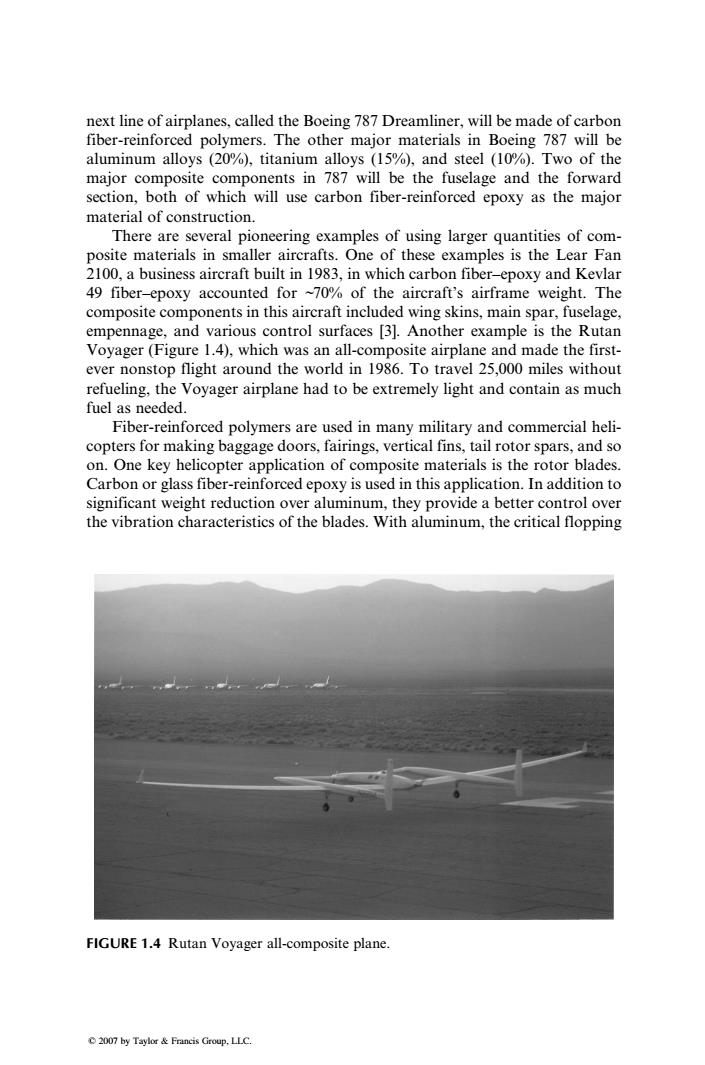正在加载图片...

next line of airplanes,called the Boeing 787 Dreamliner,will be made of carbon fiber-reinforced polymers.The other major materials in Boeing 787 will be aluminum alloys (20%),titanium alloys (15%),and steel (10%).Two of the major composite components in 787 will be the fuselage and the forward section,both of which will use carbon fiber-reinforced epoxy as the major material of construction. There are several pioneering examples of using larger quantities of com- posite materials in smaller aircrafts.One of these examples is the Lear Fan 2100,a business aircraft built in 1983,in which carbon fiber-epoxy and Kevlar 49 fiber-epoxy accounted for ~70%of the aircraft's airframe weight.The composite components in this aircraft included wing skins,main spar,fuselage, empennage,and various control surfaces [3].Another example is the Rutan Voyager(Figure 1.4),which was an all-composite airplane and made the first- ever nonstop flight around the world in 1986.To travel 25,000 miles without refueling,the Voyager airplane had to be extremely light and contain as much fuel as needed. Fiber-reinforced polymers are used in many military and commercial heli- copters for making baggage doors,fairings,vertical fins,tail rotor spars,and so on.One key helicopter application of composite materials is the rotor blades. Carbon or glass fiber-reinforced epoxy is used in this application.In addition to significant weight reduction over aluminum,they provide a better control over the vibration characteristics of the blades.With aluminum,the critical flopping FIGURE 1.4 Rutan Voyager all-composite plane. 2007 by Taylor Francis Group,LLC.next line of airplanes, called the Boeing 787 Dreamliner, will be made of carbon fiber-reinforced polymers. The other major materials in Boeing 787 will be aluminum alloys (20%), titanium alloys (15%), and steel (10%). Two of the major composite components in 787 will be the fuselage and the forward section, both of which will use carbon fiber-reinforced epoxy as the major material of construction. There are several pioneering examples of using larger quantities of composite materials in smaller aircrafts. One of these examples is the Lear Fan 2100, a business aircraft built in 1983, in which carbon fiber–epoxy and Kevlar 49 fiber–epoxy accounted for ~70% of the aircraft’s airframe weight. The composite components in this aircraft included wing skins, main spar, fuselage, empennage, and various control surfaces [3]. Another example is the Rutan Voyager (Figure 1.4), which was an all-composite airplane and made the firstever nonstop flight around the world in 1986. To travel 25,000 miles without refueling, the Voyager airplane had to be extremely light and contain as much fuel as needed. Fiber-reinforced polymers are used in many military and commercial helicopters for making baggage doors, fairings, vertical fins, tail rotor spars, and so on. One key helicopter application of composite materials is the rotor blades. Carbon or glass fiber-reinforced epoxy is used in this application. In addition to significant weight reduction over aluminum, they provide a better control over the vibration characteristics of the blades. With aluminum, the critical flopping FIGURE 1.4 Rutan Voyager all-composite plane. 2007 by Taylor & Francis Group, LLC